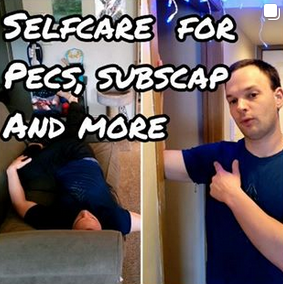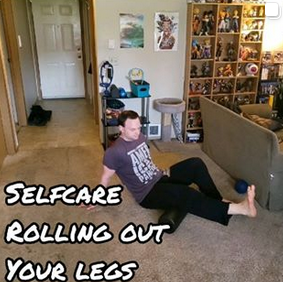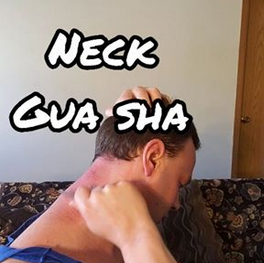Throughout our daily lives we use our body in ways that cause dysfunctions. We can teach our muscles to stay shortened and lengthened depending how we use them, and over-use of the tissue can create injuries and underuse can weaken the muscle tissue. Sprains create excess lymph causing swelling, or perhaps an injured tendon or ligament struggles to heal because of a lack of blood flow delivering proper nutrients.
Massage is a fantastic way to help your body recover, but unless you incorporate self-care you will need to return more often or your tissue will not continue to improve. This is because the body has a memory of what the muscle fibers should feel like. Self-care is required to maintain the results after a massage session. I find clients that maintain self-care continue to improve each session and have to come less frequently. This knowledge allows you to work on your issue yourself if a therapist is not available. Self-care can come in many forms including but not limited to: temperature/hydrotherapy, stretching, and using a variety of self-care and massage tools.
Temperature
Possibly the easiest forms of self-care is hydrotherapy. This can be done in a variety of ways and can be concentrated or envelope the full body. Heat Is great to bring in blood and nutrients while cryotherapy (cold therapy) is meant to move fluids back towards the heart. Temperature can be used in a variety of ways. Contrast Therapy is also a great way to use both temperatures. This involves switching between 2 minutes of heat and 1 minute of cold for 3 sets.
Temperature can be transferred in multiple ways. Heated blankets, microwavable/freezable pads, and freezing or heating towels. Perhaps the best way is to use water because it is the most efficient at transferring thermal energy and can fully engulf the area/body instead of spots. Great options for contrast therapy include: switching between hot and cold in the shower, an ice bath, or, my personal favorite, a sauna or hot tub.
Stretching
There are many ways to stretch but the 2 most common and well known are static and dynamic stretching. Both have uses and if you do the wrong style it can inhibit your training.
Static stretching is used to lengthen and relax the muscles, connective tissue, and fascia. This is accomplished by holding a stretched position for 30-60 seconds. This stretching style is not meant for physical performance as it may inhibit the fibers from firing properly. Static stretching is meant to be used as a cool down or to relax the muscle fibers. Restorative, Forest, and Yin Yoga is an excellent example of static stretching because you hold these positions often with the assistance of bolsters, blankets, and blocks for support and an easier stretch.
Dynamic Stretching is moving the muscles into a stretch and holding for only 2-3 seconds. This allows for the fibers to lengthen but does not let them relax. This is ideal for prior to physical performances as it will lengthen the fibers and prepare for movement without telling the tissue to relax.
Muscle Lengthening Tools
There are a lot of different tools you can use to lengthen and relax muscle fibers. Yoga blocks can be used to help create deeper stretches or put your body into a supported stretch that is easy on your body and can help when holding stretches for a longer period of time. Items like foam rollers can be used to lengthen the muscle by moving parallel to the muscle fiber’s direction. You can do the same with lacrosse, tennis, or massage balls and the spheres also allow for great pin and stretches and cross fiber work. Pin and stretching is when you apply pressure to a muscle spot that holds the fibers in place and as you stretch lengthens the fibers through movement. These muscle pin and stretches are designed to help the muscle relax. This is accomplished by placing your muscle on the ball with your body weight and putting the fibers through their range of motion. This will cause them to release.
Massage Tool Techniques
Massage tools used on clientele can also be used for self-care at home. Cupping and Gua Sha are great at manipulating the tissue and allows a deeper engagement with a variety of benefits. Cupping can be applied to most places on the body and lift the tissue, bring in blood flow, work out or relax the soft tissue, and assist in draining fluids. You can find an in-depth analysis on my other blog: Cupping Self-care for Body Maintenance. Gua Sha tools can take more practice and work the tissue in different ways. These tools cause micro-trauma to the muscles causing a healing response in the tissue which brings in blood. They can also be used for releasing the fascia and non-pliable soft tissue like adhesions. Check out my website for more benefits of Massage Cupping and Gua Sha.
Conclusion
Self-care is an essential component of any treatment plan. It maintains the results between sessions and can build on your tissue’s performance. The more you practice self-care on your body the more you will learn about where the discomfort is coming from and how to treat it yourself. This is especially helpful if you don’t have access to a therapist. This can range from temperature, stretching, and a variety of tools and toys. Keep adding things to your self-care toolbox and before you know it you will be your own therapist.



















Kommentare